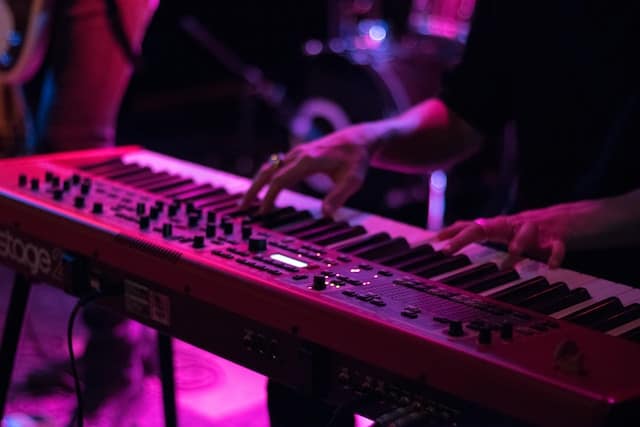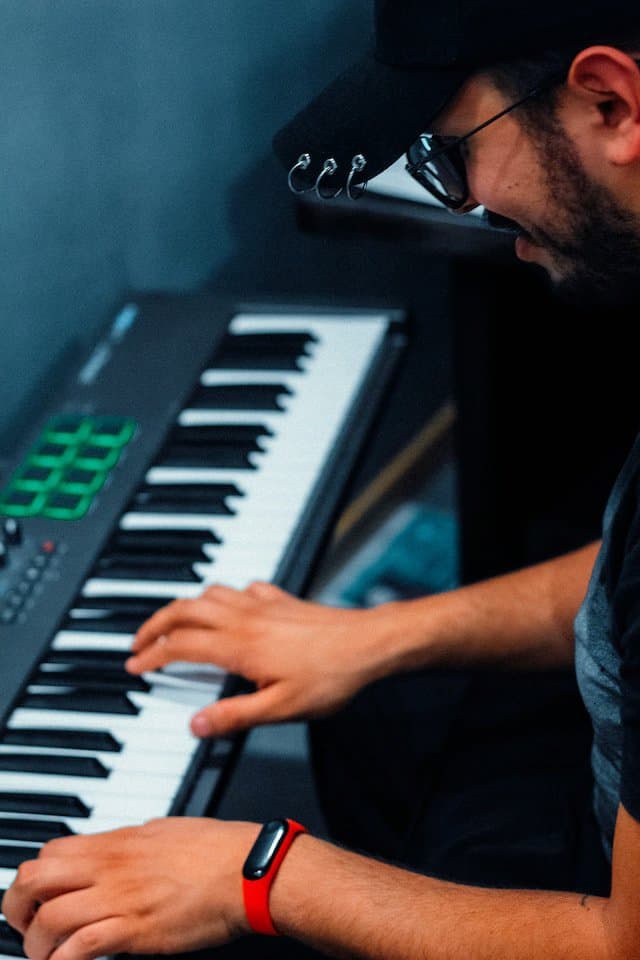Synthwave, a genre that harks back to the nostalgic sounds of the 1980s, has captivated music enthusiasts around the globe with its lush, retro-futuristic vibes. At the heart of this genre lies a fascinating exploration of musical modes and scales, which contribute to the distinctive and evocative nature of synthwave compositions. In this blog post, we’ll delve into the world of modes and scales, unraveling their significance in crafting the mesmerizing soundscapes of synthwave.
Understanding Modes and Scales:
Before we dive into the intricacies of modes and scales in synthwave, let’s briefly revisit what these musical elements entail. Modes are variations of scales, and scales are sequences of pitches arranged in ascending or descending order. In the context of synthwave, the choice of modes and scales plays a pivotal role in shaping the mood and atmosphere of a composition.

The Retro Charm of the Dorian Mode:
One of the most commonly employed modes in synthwave is the Dorian mode. Characterized by its distinctive minor scale with a raised sixth degree, the Dorian mode injects a sense of retro charm into synthwave tracks. This mode often imparts a moody and introspective feel, contributing to the genre’s nostalgic allure. Artists frequently utilize the Dorian mode to evoke a sense of longing or introspection in their compositions, creating a sonic journey that transports listeners to a bygone era.
What are the notes of the Dorian Mode:
The Dorian mode is a seven-note musical scale that is similar to the natural minor scale but with a raised sixth degree. The formula for the Dorian mode is:
1 (root) – 2 (major second) – ♭3 (minor third) – 4 (perfect fourth) – 5 (perfect fifth) – 6 (major sixth) – ♭7 (minor seventh)
In terms of steps, the intervals between the notes are:
Whole, Half, Whole, Whole, Whole, Half, Whole
If we apply this formula to a starting note (root), we can create the Dorian mode in any key. As an example, let’s create a Dorian mode starting on D:
D (root) – E (major second) – F (minor third) – G (perfect fourth) – A (perfect fifth) – B (major sixth) – C (minor seventh)
So, the Dorian mode in the key of D would be:
D, E, F, G, A, B, C
These notes together create the distinctive sound of the Dorian mode. Keep in mind that you can apply this formula to any starting note to construct the Dorian mode in different keys.
Epic Landscapes with the Aeolian Mode:
The Aeolian mode, also known as the natural minor scale, is another favorite among synthwave producers. This mode embodies a darker and more dramatic tone compared to the Dorian mode, making it ideal for crafting epic soundscapes and conveying a sense of mystery. Synthwave tracks that employ the Aeolian mode often feature emotive melodies and evocative harmonies, drawing the audience into a cinematic experience reminiscent of 80s film scores.
What are the notes of the Aeolian Mode?

The Aeolian mode is also known as the natural minor scale. It is a seven-note scale that is characterized by the following intervals:
1 (root) – 2 (major second) – ♭3 (minor third) – 4 (perfect fourth) – 5 (perfect fifth) – ♭6 (minor sixth) – ♭7 (minor seventh)
In terms of steps, the intervals between the notes are:
Whole, Half, Whole, Whole, Half, Whole, Whole
If we apply this formula to a starting note (root), we can create the Aeolian mode in any key. As an example, let’s create an Aeolian mode starting on A:
A (root) – B (major second) – C (minor third) – D (perfect fourth) – E (perfect fifth) – F (minor sixth) – G (minor seventh)
So, the Aeolian mode in the key of A would be:
A, B, C, D, E, F, G
These notes together create the natural minor scale or the Aeolian mode. As with the Dorian mode, you can apply this formula to any starting note to construct the Aeolian mode in different keys.
Futuristic Flourishes with the Ionian Mode:
While many synthwave compositions draw inspiration from the melancholic tones of the Dorian and Aeolian modes, some artists opt for the Ionian mode to infuse a more optimistic and futuristic vibe. The Ionian mode, also known as the major scale, introduces a sense of brightness and positivity into synthwave tracks. This mode is often used in uplifting and energetic compositions, creating a dynamic contrast to the genre’s more introspective offerings.
What the notes of the Ionian Mode?
The Ionian mode is also known as the major scale. It is a seven-note scale that is characterized by the following intervals:
1 (root) – 2 (major second) – 3 (major third) – 4 (perfect fourth) – 5 (perfect fifth) – 6 (major sixth) – 7 (major seventh)
In terms of steps, the intervals between the notes are:
Whole, Whole, Half, Whole, Whole, Whole, Half
If we apply this formula to a starting note (root), we can create the Ionian mode in any key. As an example, let’s create an Ionian mode starting on C:
C (root) – D (major second) – E (major third) – F (perfect fourth) – G (perfect fifth) – A (major sixth) – B (major seventh)
So, the Ionian mode in the key of C would be:
C, D, E, F, G, A, B
These notes together create the major scale or the Ionian mode. As with the other modes, you can apply this formula to any starting note to construct the Ionian mode in different keys.
Experimentation and Innovation:

One of the hallmarks of synthwave is its willingness to experiment and push boundaries. As a result, artists frequently blend various modes and scales, creating hybrid soundscapes that defy traditional categorizations. This spirit of experimentation allows for the continual evolution of the genre, keeping it fresh and exciting for both creators and listeners.
Conclusion:
In the realm of synthwave, the careful selection and manipulation of modes and scales serve as the foundation for crafting the genre’s captivating sonic tapestry. Whether invoking the nostalgic allure of the Dorian mode, the epic landscapes of the Aeolian mode, or the futuristic optimism of the Ionian mode, synthwave artists skillfully navigate the musical spectrum to transport their audience into a world where past and future converge in a mesmerizing harmony. As the genre continues to evolve, the exploration of modes and scales remains a key element, ensuring that synthwave remains a vibrant and ever-evolving force in the world of electronic music.
Recent Posts
Exploring the Analog vs. Digital Debate in Synthwave Music Production
In the realm of electronic music production, particularly within the vibrant genre of synthwave, the debate between analog synthesizers and digital VSTs (Virtual Studio Technology) has been an...
In the world of music composition, the choice of key can significantly influence the mood, emotion, and overall feel of a song. Each key has its own unique characteristics, from the bright and...

